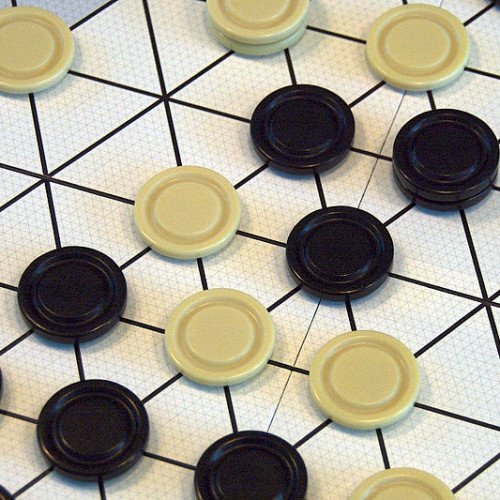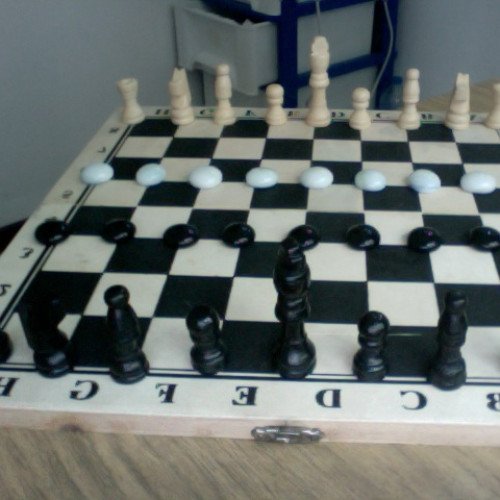GIPF VS OUK-KHMER

GIPF
GIPF is an abstract strategy board game by Kris Burm, the first of six games in his series of games called the GIPF Project. GIPF was recommended by Spiel des Jahres in 1998. Players take turns pushing tokens (one player taking black, the other white) from the edge of the tri-gridded, hexagonal board, with pieces already in play pushed in front of the new placements rather than allowing more than one piece on any space. The game is lost if a player has no more tokens to play, and since each starts with a set number of tokens, it is clearly necessary to recycle pieces already positioned to keep playing. This is achieved by contriving to line up four pieces of the same colour in a row on the board, at which point those tokens are returned to their owner, and any opposing tokens extending from the line of four are captured. Because a single player will often move several pieces and change numerous on-board relationships, it is remarkably difficult to predict the state of the board more than one turn ahead, despite GIPF being a game of perfect information. Play tends to be highly fluid and there is no real concept of long term territorial or spatial development. The game can be expanded with extra pieces (available separately) called Potentials, which allow different kinds of moves to be made. These are named for the other games in the GIPF Project, though the other games are not actually necessary in order to utilise the Potentials named after them.
Statistics for this Xoptio

OUK-KHMER
Ouk-Khmer (also known as Cambodian Chess) is a chess variant which D. B. Pritchard claimed was played in Cambodia although its actual origins appear to be unknown. Pritchard gives the source as P. A. Hill. It combines elements of makruk and xiangqi. Similar to xiangqi, it is played on the intersections of an 8×8 monotone board (instead of 8×9). Contrary to Pritchard's claim, the actual variety of chess played in Cambodia today, known as "Ok" or "Ouk Chatrang", is nearly identical to makruk. The authenticity of the game described by Pritchard remains doubtful. Pritchard (The Encyclopedia of Chess Variants, 1994) described this game as "an old variant displaying elements of Burmese Chess, Chaturanga and Makruk". However, the rules provided appear to be a hybrid of Makruk and Xiangqi. For example, play on the intersections and the movement of the fish (pawn) follow Xiangqi rules. The advanced placement of the full line of pawns resembles the initial setup of makruk. The naming of the "boat" also follows makruk. John Gollon, the author of "Chess Variations: Ancient, Regional, and Modern", received a description of a chess game in 1969 from a U.S. serviceman who claimed to have obtained the details from a Cambodian born guerrilla officer he was questioning. The serviceman expressed concern that he may have been mistaken about some of the details and Gollon stated that he was never able to confirm the details with an official Cambodian source. He admitted in his letter: “The correspondent later expressed some concern that he may have been mistaken in some details.” In 2007, the English chess specialist John Beasley published a revised edition of late D.B.Pritchard's book (The Classified Encyclopedia of Chess Variants), in which more details from Gollon's letter were given (such as the local names of the chessmen, not included in the 1st edition) and where Beasley expressed his strong doubt about the authenticity of this kind of chess. In reaction to this publication, Beasley was sent information that a set of this chess had made an apparition in an exhibition in Tokyo in 2002 as well as in several Japanese books that preceded or followed, written by Umebayashi Isao and Okano Shin. They could have rediscovered these rules by translating a book bought in Cambodia, where the Elephant could not capture sideways. The names they gave for the chessmen were somewhat different from Gollon (Kwon, Neamahn, Kwo, Seh, Tuuk, Trey as for the table). Umebayashi and Okano designated that game as "shattrong". A photo of a complete set was available showing the 18 pieces on a board with marked diagonals. Beasley published a corrective note in the British specialized magazine Variant Chess (Issue 55, September 2007 and issue 64, August 2010 ) to acknowledge this second “evidence”. He acknowledged that the game is apparently absent "from the streets of Phnom Penh in 2003" and stated that Peter suggested "that this may have been a minor consequence of the mass killings of the Pol Pot era.". The situation has been cleared out in 2012 with the help of a Japanese chess researcher, Yasuji Shimuzu who got in touch with Umebayashi Isao. First, it has been now understood that Umebayashi and Okano's books were simply presenting a reconstruction of the “Cambodian” chess which they had discovered in Pritchard's first edition. As Pritchard didn't name the chessmen in his first edition, the Japanese authors extrapolated the names with the help of a dictionary. No Cambodian books had been consulted and even found. The difference in Elephant's move was simply a misreading. Finally, looking for an illustration, they just set up a set of makruk with additional Fishes and Officials over a facsimile Burmese board that they had and fitted well the size of his chessmen. John Beasley published a corrective note on his website http://www.jsbeasley.co.uk/. His conclusion is that the game described to P. A. Hill in 1969 appeared once more to reduce to a single informant whose statements were at variance with all other known testimony. Moreover, John Beasley has found and proven that the game is flawed if played seriously.